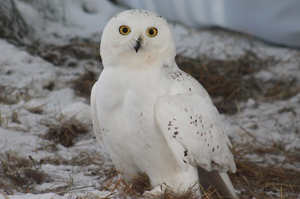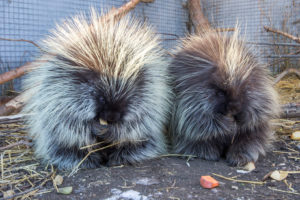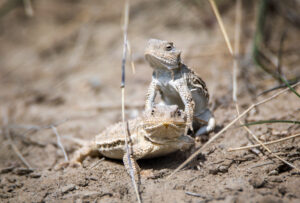About two or three years ago, I spotted the largest number of snowy owls I had ever seen in southern Alberta. I haven’t seen as many this winter season, and began to wonder if there was a reason for this. Maybe I have been spending less time out of the city this winter, I’m getting rusty at spotting them or maybe there is some other driving force that influences the snowy owl population size.
As an environmental scientist, I am familiar with the snowshoe hare-lynx population cycle so I did a little research to see if there was a similar population cycle with the snowy owl and one of their prey species.
The way the snowshoe hare-lynx population cycle works is like this:
- The hare population size increases when the population size of their predator—the lynx—is low.
- As the hare population continues to increase due to predation by lynx being low, the lynx population begins to increase due to the abundance of preferred food, the snowshoe hare.
- The snowshoe hare population eventually declines due to heavy predation brought on by the booming lynx population.
- The lynx population follows the declining snowshoe hare trend shortly after with their own decline due to less available food.
The cycle continues like this, with booms and busts for each species (Northwest Territories Environment and Natural Resources). Of course, there are more factors that can come into play, but that is a simplified version.
With the snowy owl, there has been speculation and several recent studies on the relation between the snowy owl and lemming populations (Fears 2014; Smith 2014). Lemmings are small rodents that are related to voles and inhabit northern Canada. They reproduce quickly and reach peak population sizes every three to five years (Canadian Encyclopedia 2017).
There are two popular theories that explain lemming population cycles (Smith 2014):
- Predators, such as the snowy owl drive lemming population cycles.
- Lemmings drive their own population declines through over-population and overgrazing, which can lead to large scale die-offs.
In the summer of 2013, there was an abundance of lemmings in northern Canada. This resulted in high reproductive success rates for snowy owls and an abundance of snowy owl fledglings successfully leaving their nests. Because there were so many new owls the following winter season during their migration south, many of the young owls distributed themselves further south and closer together than normal (Fears 2014; Smith 2014). This is what lead to me seeing more snowy owls than ever before!
Lemming population booms have virtually stopped in Greenland and the Scandinavian Arctic (Fears 2014). Global warming is causing decreases in snow cover and changes in snow texture (IPCC 2014), which is believed to be causing the change in lemming population booms. Arctic Canada has also seen a trend of decreasing snow cover and increases in permafrost and surface temperatures (IPCC 2014). As trends continue in this direction, they will not favor the lemming and I speculate that we can expect to see population booms of the snowy owl become fewer and farther between.
AIWC usually receives a few snowy owls each year. Head over to our Adopt an Animal page (https://www.aiwc.ca/support-us/adopt-an-animal/) or call us at 403-946-2361 to help support a large raptor today!
By Tayler Hamilton, AIWC Volunteer
Sources:
Canadian Encyclopedia. 2017. Lemming. Available at: https://www.thecanadianencyclopedia.ca/en/article/lemming/
Fears, Darryl. 2014. Lemmings fuel biggest snowy-owl migration in 50 years. Guardian Weekly. Available at: https://www.theguardian.com/environment/2014/feb/24/snowy-owl-lemming-population-us-canada
IPCC (Intergovernmental Panel on Climate Change). 2014. Climate Change 2014: Synthesis Report. Contribution of Working Groups I, II and III to the Fifth Assessment Report of the Intergovernmental Panel on Climate Change [Core Writing Team, R.K. Pachauri and L.A. Meyer (eds.)]. IPCC, Geneva, Switzerland, 151 pp. Available at: https://www.ipcc.ch/pdf/assessment-report/ar5/syr/SYR_AR5_FINAL_full_wcover.pdf
Northwest Territories Environment and Natural Resources. Date unknown. Lynx-Snowshoe Hare Cycle. Available at: https://www.enr.gov.nt.ca/node/3052
Smith, Joe. 2014. The Amazing Lemming: The Rodent Behind the Snowy Owl Invasion? Cool Green Science: by Smarter Nature. Available at: https://blog.nature.org/science/2014/01/21/the-amazing-lemming-the-rodent-behind-the-snowy-owl-invasion/






